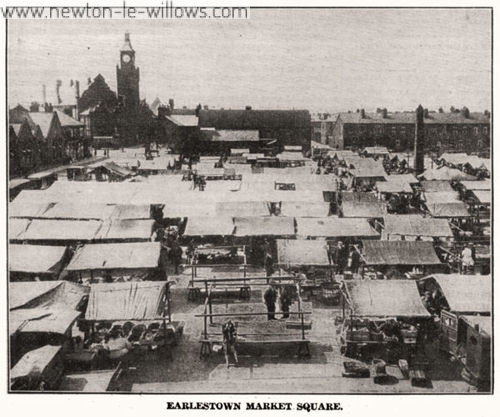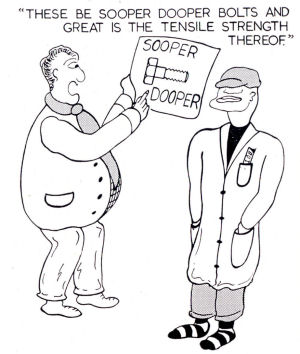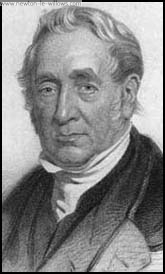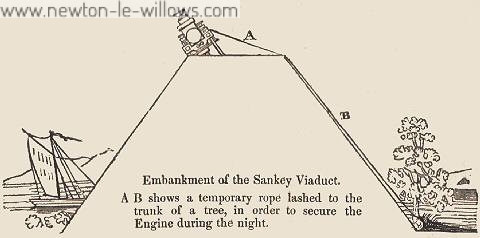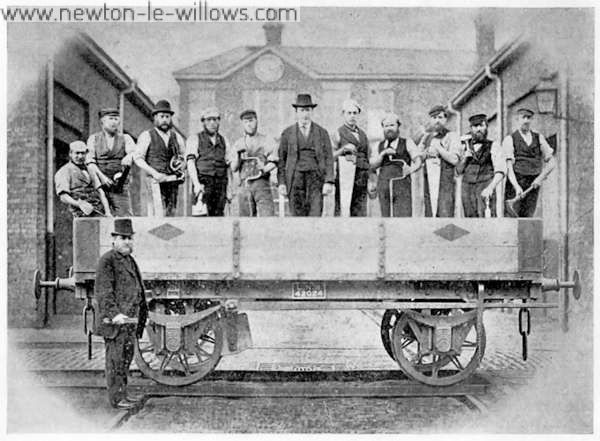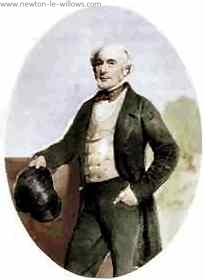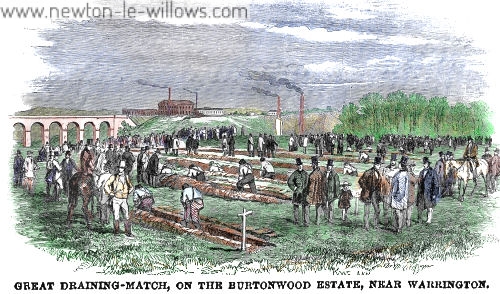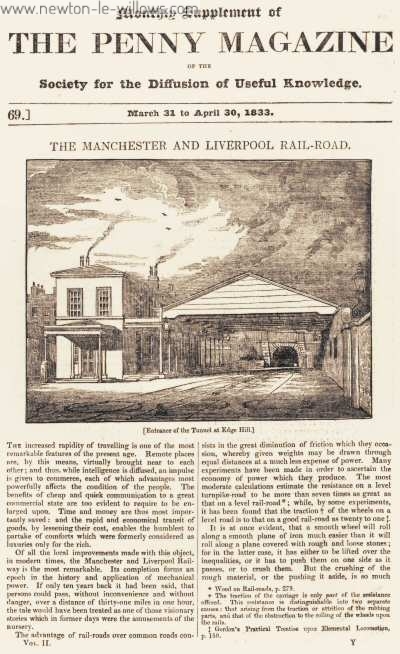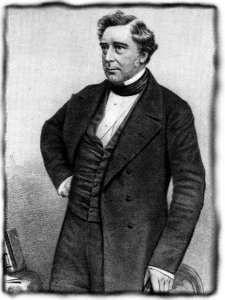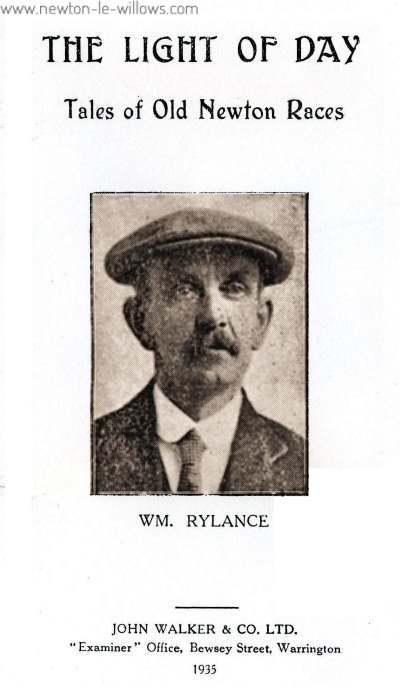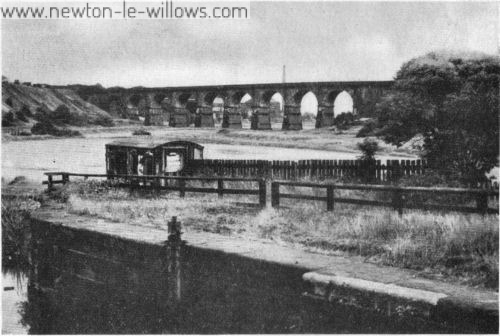In 42nd Henry III. (1258), Robert Banastre, the fourth baron of that name, obtained the Kings charter for a fair and market at his manor of Newton . Forty-three years afterwards a market and two fairs were granted by Edward I. to John de Langton – the market to be held every Saturday, and the fairs on the eve,day, and morrow of St. John (6th May) and of St. Germain (31st July). In 1536 the former was described by Leland (King Henry VIII.s antiquary) as “a little poore market.” This…
Read More >>Category: Earlestown
The Fable of the Inspector and the Bolts
VULCAN MAGAZINE , Autumn 1958 THE FABLE OF THE INSPECTOR AND THE BOLTS There dwelt in the City of Newt an Inspector of a Factory, and his Chief spake unto him saying:- “Lo, there is in the wilderness of Vul a maker of bolts, and he has made two score and five special bolts. These be Sooper-Dooper bolts and great is the tensile strength thereof, that they may fix, even the very top of a cylinder casing, even unto the very bottom. Get thee hence and inspect them. And take…
Read More >>History of the Vulcan Foundry
History of the Vulcan Foundry , Newton le Willows 1781 George Stephenson was born at Wylam-on-Tyne, Northumberland. 1785 Charles Tayleur was born. 1803 Robert Stephenson was born at Willington Quay, Northumberland. 1816 Daniel Gooch was born in Bedlington, Northumberland, on 24th August, 1816 1823 George Stephenson founded a locomotive works at Newcastle-on-Tyne. 1829 The Rocket was built by Robert Stephenson & Co. won the prize of ?500 at the Rainhill Trials that were held to determine the most suitable type of locomotive for the new Liverpool and Manchester Railway. 1830…
Read More >>Sankey Viaduct Train Derailment
LIVERPOOL AND MANCHESTER RAILWAY?FURTHER PARTICULARS. Performance of the Engines. It has been stated in several of the newspapers, by way of apology for the delay which took place in the re-turn of the rear division of the pro-cession from Manchester on the day of the opening, that it arose from an apprehension that, as night had come on, accidents might have arisen from proceeding at a more rapid rate. The authors of this apology forget that at the same time the night came on the expectant crowds went off, and…
Read More >>James Muspratt (1793 – 1896)
James Muspratt was born in Dublin on the 12th August, 1793; his father was an Englishman, whose brother was a director of the East India Company; his mother, who was a remarkable woman of fine character and culture, was a Miss Mainwaring, one of the Cheshire family of that name. They resided in Dublin, and to a commercial school in that city sent their son. At fourteen years of age he was taken from school and apprenticed to a Mr. Mitcheltree, a wholesale chemist and druggist, in Dublin, with whom…
Read More >>The Viaduct Foundry
As the Vulcan and Viaduct Foundries swung into production skilled workers were attracted from other parts of Lancashire as well as further afield. To house their workers Stephenson and Tayleur built a model village beside their factory, Vulcan Village. Originally only of three rows it was developed as the factorys business increased. Seeing the advantages to be gained from setting up a factory in Newton where skilled labour was becoming available, two other business partners founded the firm of Jones and Potts and built a factory known as the Viaduct…
Read More >>Sir Hardman Earle (1792 – 1877)
Sir Hardman EarleHardman Earle was born 11 JUL 1792, and died 25 JAN 1877, for Earlestown one of the most important days of his life was the 1st March 1853, This was the day that the London and North Western Railway, under the direction of Sir Hardman Earle, leased from Messrs. Jones & Potts a small works known as the Viaduct FoundryIn 1853 there were only around 30 houses available for the viaduct workers but as the foundry became busier, it expanded and the houses and town that was built…
Read More >>Earlestown Wagon Works: the Viaduct Foundry
One hundred and fifty one years ago, on March 1, 1853, the London & North Western Railway leased from Jones & Potts a small engineering works known as the Viaduct Foundry, so named from its proximity to Stephensons Sankey Viaduct over the St. Helens Canal on the original Liverpool & Manchester Railway. Seven years later, on May 11, 1860, the L.N.W.R. purchased the property outright for the sum of 15,000. The Viaduct Works was founded by Jones, Turner & Evans in 1833, and among other products, including pumping machinery for…
Read More >>Burtonwood: Agricultural Draining Match – 1853
The London Illustrated News, 3rd Dec 1853ON Wednesday week, the 23rd ult., an extensive Agricultural Draining Match was held on the Burtonwood Estate, the property of Samuel Brooks, Esq., banker, of Manchester, situate near the Warrington Junction station of the Liverpool and Manchester Railway. The field selected was well adapted for the purpose, and beautifully situated, commanding a magnificent view of the Sankey viaduct. The soil consists of a friable loam, on a marly substratum, with occasional beds of clay and sand. The attendance of drainers and gentlemen interested in…
Read More >>The Manchester and Liverpool Rail-Road
The Manchester and Liverpool Rail-Road The increased rapidity of traveling is one of the most remarkable features of the present age. Remote places are by this means, virtually brought near to each other; and thus, while intelligence is diffused, an impulse is given to commerce, each of which advantages most powerfully effects the condition of the people. The benefits of cheap and quick communication to a great commercial state are too evident to require to be en-larged upon. Time and money are thus most importantly saved: and the rapid and…
Read More >>The Sankey Viaduct ( Nine Arches Bridge )
It was then that the wealthy Quaker Joseph Sandars met William James, who proposed a railway which he undertook to build in 18 months at a cost of £100,000. Though his offer was accepted, long delays then occurred and by 1824 he was succeeded by George Stephenson as the company’s engineer. The next year a Parliamentary Bill was introduced, but it failed principally owing to Stephensons inability to answer questions on his survey by opposing counsel. He was accordingly dismissed by the board, who appointed the professional civil engineers Sir…
Read More >>Earlestown: A History
Newton le Willows had for years had a glass works, making bottles and flat glass, this flat glass was at the time made by spinning out a large blob of glass into a large circular plate, and then cutting from this large flat plate, the largest square or rectangles possible from the centre to the edge, because the flat glass was taken from this spinning out of a single blob, it meant it was pretty impossible to make a very large single sheet of glass, the max size available, no…
Read More >>Tales of Old Newton Races
FOREWORD. This little book, written by Mr. William Rylance, will gain in value as the years roll on. The customs he records have changed, are changing, and will continue to change; and these descriptions of what has been, presented in graphic language by one who had first-hand knowledge of the things of which he spoke, will provide reliable material for the future historian of our social life. Moreover, the stories have a present interest and worth. They cannot but make a strong appeal to all who love to read of…
Read More >>Sankey Viaduct and Embankment
Although the Stockton & Darling-ton Railway was the first public railway on which locomotives were used, the Liverpool & Manchester Railway was the first in the accepted sense of the word today. The scheme for a railway between the great port of Liverpool and the thriving cotton-manufacturing town of Manchester, was first entertained as a practical proposition in 1821, when a preliminary survey of the proposed line was made. The company was formed in 1824, and George Stephenson was appointed Chief Engineer in 1826. The route had to be amended…
Read More >>BOB CARLISLE – “The Walker”
My earliest recollection on my way home from St. Johns School at the corner of Legh St. and Market St., and one that stands out very clearly in my mind, is of seeing a man walking round and round Earlestown Market Square. I was later to learn that his name was Bob Carlisle, and he was repeating a feat of walking one thousand miles in one thousand hours, at not more than one mile an hour. This had been performed some time before for a wager between some very prominent…
Read More >>